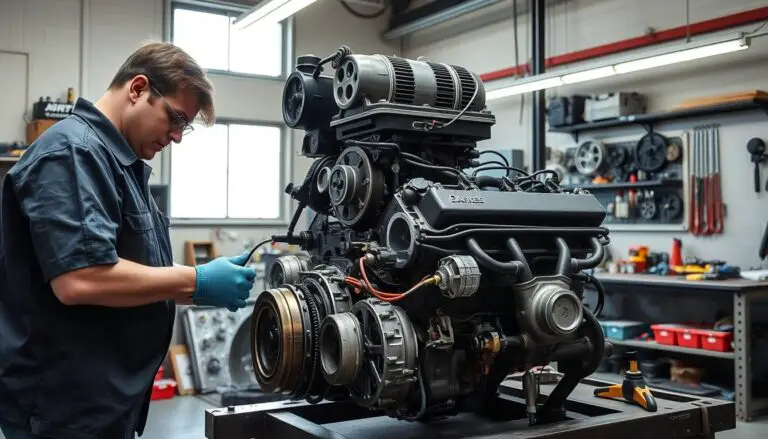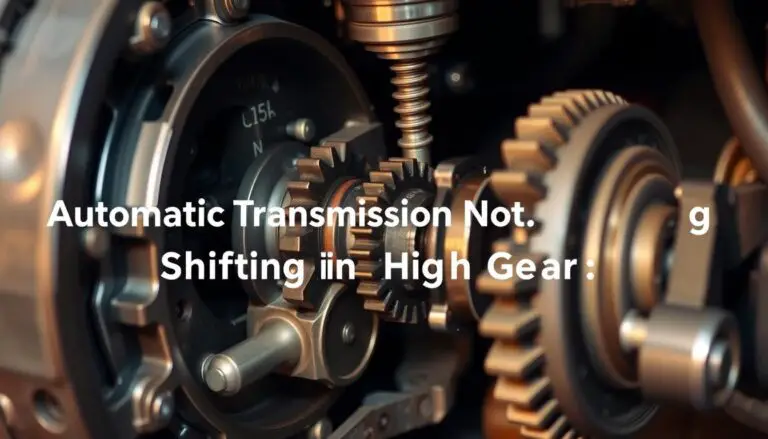For the adept DIY mechanic, the task of addressing malfunctions within the air conditioning system may initially appear formidable. Yet, the process of how to jump an AC pressure switch is remarkably straightforward. This comprehensive guide aims to elucidate the essential steps required for diagnosing and potentially resolving issues with your vehicle’s AC system.
Repairing your vehicle’s AC system does not necessitate a complex approach. By adhering to this guide, you will acquire a foundational understanding of DIY AC repair and develop the confidence to undertake basic repairs. The methodology entails grasping the AC pressure switch’s role and the procedure for its bypass when required.
Key Takeaways
- Understand the function of the AC pressure switch in your vehicle’s AC system.
- Learn the simple steps to jump the AC pressure switch.
- Gain confidence in performing basic DIY AC repairs.
- Identify when professional help is needed for more complex issues.
- Save time and money by tackling simple AC repairs yourself.
Understanding AC Pressure Switches and Their Function
For DIY mechanics, comprehending the role and operation of AC pressure switches is fundamental to effective car AC troubleshooting. These switches are indispensable, serving as guardians of the air conditioning system’s integrity by monitoring pressure levels. Their function is to avert potential damage to the system.
What Is an AC Pressure Switch and How Does It Work
An AC pressure switch acts as a sentinel, safeguarding the air conditioning system from perilous pressure conditions. It vigilantly observes refrigerant pressure, triggering the compressor’s shutdown when pressures deviate from the norm. This protective mechanism is designed to safeguard against system damage.
Common Reasons Why AC Pressure Switches Fail
AC pressure switches may fail due to exposure to extreme temperatures, corrosion, or physical damage. A malfunctioning switch can precipitate system malfunctions, manifesting as diminished cooling efficacy or complete system collapse.
When Jumping a Pressure Switch Is Appropriate vs. When It’s Not
Jumping a pressure switch can serve as a temporary expedient for diagnostic or bypass purposes. Yet, it is imperative to recognize that this approach is not a definitive repair and carries inherent risks. It is suitable for diagnostic endeavors but should not be considered a viable long-term solution.

| Condition | Jumping Appropriate | Recommended Action |
|---|---|---|
| Faulty Switch | Yes (for diagnosis) | Replace switch |
| Low Refrigerant | No | Recharge refrigerant |
Safety Precautions Before Jumping an AC Pressure Switch
Engaging in the act of jumping an AC pressure switch necessitates a profound comprehension of the safety protocols integral to a successful DIY AC repair endeavor. This activity entails interaction with both electrical and mechanical facets of your vehicle’s air conditioning apparatus, a realm fraught with peril if approached with negligence.
Personal Safety Equipment Required
Adherence to safety is paramount; thus, the donning of protective gear is imperative. This ensemble, comprising gloves, safety glasses, and a face mask, serves as a bulwark against the perils of electrical shock, chemical splashes, and other hazards inherent in AC system maintenance.
Vehicle Safety Measures
Ensure your vehicle is positioned on a level terrain and that the parking brake is firmly engaged. This precautionary measure is designed to avert any unforeseen vehicular movement, thus mitigating the risk of injury or system damage during the repair process.
Understanding the Risks to Your AC System
The act of jumping a pressure switch harbors risks to your AC system, including the possibility of compressor or other component damage if executed improperly. Acknowledgment of these risks is crucial for the implementation of appropriate protective measures.

Tools and Materials Needed for the Job
Initiating the process of jumping an AC pressure switch necessitates the compilation of requisite tools for AC repair and materials. The acquisition of appropriate equipment is paramount, ensuring the execution of the task is both efficient and safe.
Essential Tools for Jumping an AC Pressure Switch
The fundamental tools encompass a multimeter for verifying electrical continuity, a set of screwdrivers for accessing the pressure switch, and pliers for wire manipulation. For systems of greater complexity, the inclusion of a wiring diagram specific to your vehicle becomes indispensable. Such diagrams and guides are readily available in resources such as this technical document.
Materials for Creating a Proper Jumper Wire
In the fabrication of a jumper wire, a segment of electrical wire, preferably of gauge suitable for automotive applications (18-20 AWG), is required, along with wire connectors or soldering apparatus. The wire must be insulated and capable of withstanding the electrical current, a critical aspect for safety.
Organizing Your Workspace for Efficiency
A meticulously organized workspace is essential for the expedient completion of the task. Tools and materials should be positioned within immediate reach, with the workspace illuminated adequately and devoid of distractions. This approach not only accelerates the process but also diminishes the likelihood of errors.
How to Jump AC Pressure Switch: A Step-by-Step Guide for DIY Mechanics
Jumping an AC pressure switch necessitates the possession of appropriate tools and an understanding of the process. This guide aims to elucidate each step, facilitating the diagnosis and potential rectification of AC system malfunctions in your vehicle.
Locating the AC Pressure Switch in Your Vehicle
The initial step involves identifying the AC pressure switch’s location. This can vary significantly based on the vehicle’s make and model.
Common Locations by Vehicle Type
The AC pressure switch is generally situated near the air conditioning compressor or along the refrigerant lines. It is predominantly located on the high-pressure side of the AC system in most vehicles.
Identifying the Correct Switch
Verify the correct switch by consulting your vehicle’s repair manual or examining labels on the AC components.
Preparing Your Vehicle and Workspace
Ensure your vehicle is parked on a level surface and the parking brake is applied before commencing.
Ensuring the Engine is Off and Cool
Switch off the engine and allow it to cool down. This precaution is essential to prevent accidental starts and injuries.
Accessing the AC System Safely
Ensure unobstructed access to the AC system components. You may need to remove other components or covers to access the pressure switch.
Disconnecting the Pressure Switch
Once the pressure switch’s location and access are confirmed, the next step is to disconnect it.
Proper Disconnection Techniques
Utilize a wrench or pliers to loosen any fittings securing the switch. Gently pull the electrical connector off the switch.
Inspecting for Visible Damage
Examine the switch while disconnected for any signs of damage or wear. This can help determine if the switch requires replacement.
| Inspection Point | What to Look For |
|---|---|
| Electrical Connector | Signs of corrosion or wear |
| Switch Body | Cracks or physical damage |
| Fittings and Mounting | Loose or damaged fittings |
Creating and Installing the Jumper Wire
A jumper wire is employed to bypass the pressure switch, enabling the testing of the AC system’s functionality.
Proper Wire Selection and Preparation
Select a wire compatible with the electrical system’s voltage and current. Strip the wire ends to ensure good contact.
Secure Installation Methods
Connect the jumper wire across the terminals of the pressure switch connector. Ensure the connection is secure to avoid any electrical issues.
Testing the AC System After Jumping
With the jumper wire in place, test the AC system to verify its proper operation.
What to Look and Listen For
Activate the AC and listen for any unusual noises. Verify if the compressor engages and if cold air is produced.
Confirming Proper Operation
If the AC operates correctly with the jumper wire in place, it suggests the pressure switch might be faulty. Further diagnosis may be necessary, though.
Temporary Fix vs. Permanent Repair: What You Need to Know
Understanding the distinction between a temporary fix and a permanent repair is paramount when addressing a malfunctioning AC pressure switch. While a temporary solution, such as jumping the switch, may restore functionality, it is imperative to discern when such a measure is adequate versus when a more enduring solution is necessary.
How Long You Can Safely Run with a Jumped Switch
The practice of running with a jumped AC pressure switch serves as a temporary solution, yet it harbors inherent risks. The duration of safe operation under such conditions is contingent upon several variables, including the underlying cause of the switch failure and the AC system’s overall state. For comprehensive insights into managing AC system malfunctions, refer to this article on manually engaging the AC compressor clutch.
Signs That Indicate Immediate Professional Repair
There are specific indicators that necessitate immediate professional intervention. These include:
- Persistent issues with the AC system following a switch jump
- Unusual noises emanating from the AC compressor or other components
- Visible signs of leakage or damage to the AC system
Cost Comparison: DIY Jump vs. Professional Replacement
The financial disparity between a DIY jump and a professional replacement is considerable. While a DIY jump is relatively inexpensive, requiring only basic tools and some technical acumen, a professional replacement entails labor costs and potentially additional expenses, contingent upon the necessity for replacement of other components.
In conclusion, while a temporary fix may appear attractive due to its immediacy and potentially lower initial cost, it is vital to consider the long-term implications and safety aspects. A thorough cost comparison between a DIY jump and a professional replacement will facilitate an informed decision, aligning with your specific needs and financial constraints.
Conclusion
The act of jump-starting an AC pressure switch, when executed with precision, emerges as a manageable endeavor for the adept DIY mechanic. This guide has delineated the necessary steps, empowering individuals to adeptly diagnose and provisionally rectify malfunctions within their vehicle’s air conditioning apparatus.
Grasping the AC pressure switch’s role and adhering to safety protocols are paramount for a successful DIY intervention. The procedure necessitates the identification of the switch’s location, preparation of the vehicle, disconnection of the switch, fabrication of a jumper wire, and subsequent testing of the AC system’s functionality.
Though the expedient solution of jump-starting the AC pressure switch may offer temporary relief, it is imperative to uncover the root cause of the malfunction. Persistent issues necessitate professional intervention to prevent irreparable damage to the AC system.
Through the acquisition of knowledge from this comprehensive automotive DIY guide, individuals are equipped to undertake AC pressure switch repair with confidence. This ensures the optimal performance of their vehicle’s air conditioning system.
FAQ
What is an AC pressure switch and why is it important?
An AC pressure switch is a critical safety mechanism within an air conditioning system, tasked with monitoring refrigerant pressure levels. Its primary function is to prevent system damage by automatically shutting down the compressor when pressure thresholds are exceeded or fall below acceptable ranges.
Can I jump an AC pressure switch on any vehicle?
Jumping an AC pressure switch is not universally applicable across all vehicle models. The suitability of this procedure hinges on the specific design of the vehicle’s AC system and its compatibility with the switch’s functionality. Always refer to the manufacturer’s repair manual or seek professional guidance before attempting to bypass the switch.
What are the risks of jumping an AC pressure switch?
Engaging in the practice of jumping an AC pressure switch can introduce significant risks to the integrity of the AC system. Potential damage to the compressor, condenser, or other critical components may occur due to improper pressure levels. This method also carries inherent safety hazards if not executed with precision.
How long can I safely run my AC with a jumped pressure switch?
Utilizing a jumped AC pressure switch is considered a temporary expedient. The duration of safe operation is contingent upon several variables, including the reason for the bypass and the system’s overall condition. It is imperative to have a professional assess and rectify or replace the switch as expeditiously as possible.
What are the signs that indicate I need to have my AC pressure switch professionally repaired or replaced?
Indications that necessitate professional intervention include persistent AC performance issues, system leaks, unusual noises, or continued problems post-switch bypass. If you are not adept in DIY repairs or your vehicle’s AC system is complex, professional assistance is strongly advised.
Is it cost-effective to jump an AC pressure switch as a DIY project?
Jumping an AC pressure switch can serve as a cost-effective interim solution, as it obviates the need for a new switch purchase. Yet, neglecting to address the underlying issue may lead to more substantial repair expenses in the future. A thorough cost-benefit analysis is necessary to determine whether a DIY jump or professional replacement is more economical.
Can jumping an AC pressure switch cause damage to other components in my vehicle’s AC system?
Yes, improper jumping of an AC pressure switch can potentially damage other system components, notably the compressor, due to abnormal pressure conditions. Adherence to proper procedures and a thorough understanding of the implications of bypassing the switch are paramount to avoid such complications.


